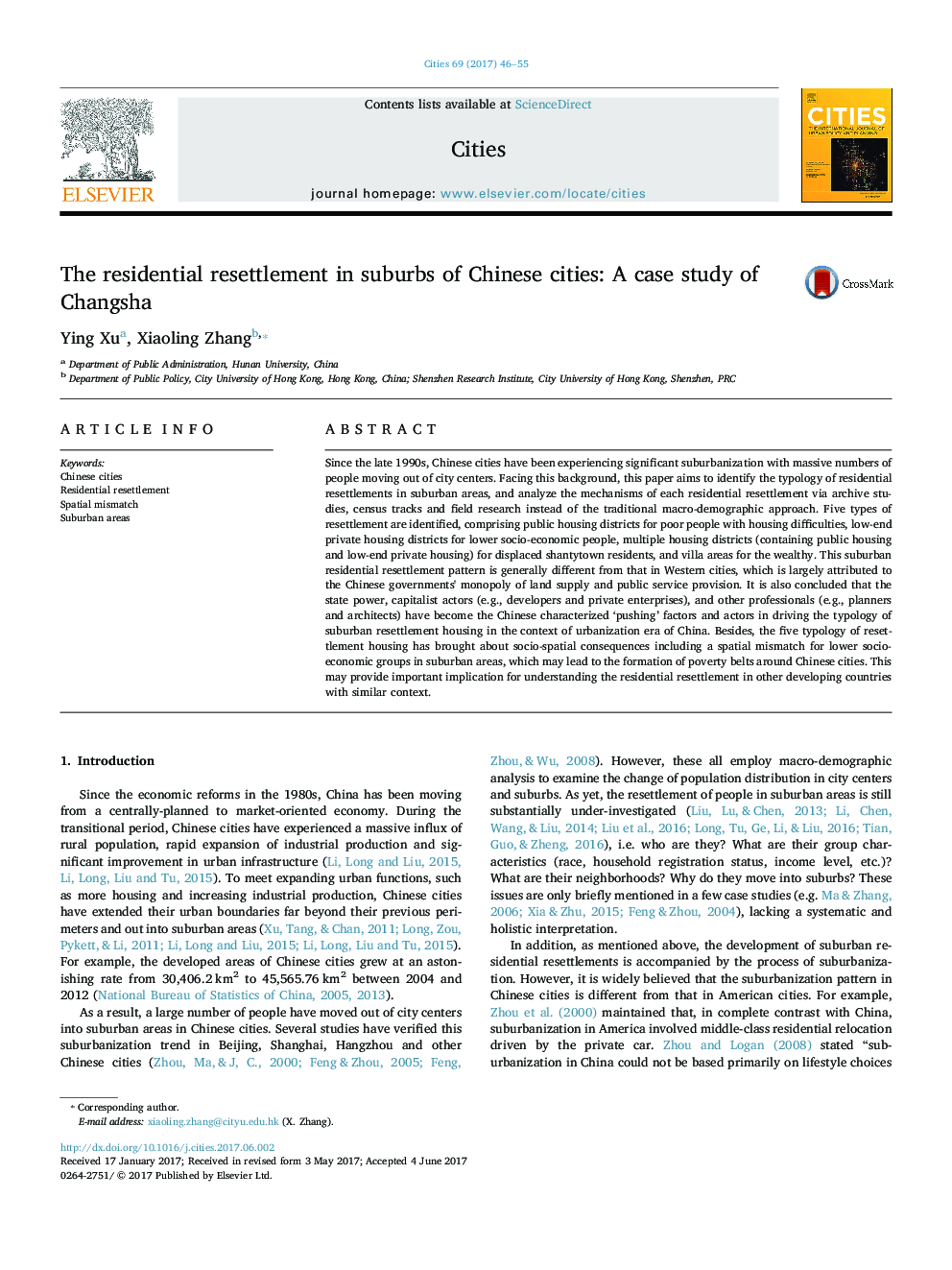| کد مقاله | کد نشریه | سال انتشار | مقاله انگلیسی | نسخه تمام متن |
|---|---|---|---|---|
| 5108024 | 1482327 | 2017 | 10 صفحه PDF | دانلود رایگان |
عنوان انگلیسی مقاله ISI
The residential resettlement in suburbs of Chinese cities: A case study of Changsha
ترجمه فارسی عنوان
اسکان مجدد مسکونی در حومه شهر های چینی: مطالعه موردی چانگشا
دانلود مقاله + سفارش ترجمه
دانلود مقاله ISI انگلیسی
رایگان برای ایرانیان
کلمات کلیدی
شهرهای چینی، اسکان مجدد مسکونی، عدم انطباق فضایی، مناطق حومه،
ترجمه چکیده
از اواخر دهه 1990، شهر های چینی با حومه شهر های قابل توجهی روبرو هستند که تعداد زیادی از مردم از مراکز شهر خارج می شوند. با توجه به این پیشینه، این مقاله با هدف شناسایی گونه شناسی اسکان مجدد مسکونی در مناطق حومه و بررسی مکانیزم های هر اسکان مجدد مسکونی از طریق مطالعات آرشیو، تراکنش های سرشماری و تحقیقات میدانی به جای رویکرد مرسوم جمعیت شناسی سنتی است. پنج نوع اسکان مجدد شناسایی شده است: شامل مناطق شهری عمومی برای افراد فقیر با مشکلات مسکن، مناطق مسکونی کم درآمد برای افراد کمتر اجتماعی و اقتصادی، مناطق مسکونی چندگانه (شامل مسکن عمومی و مسکن خصوصی کم) برای ساکنین آواره شده و ویلاها برای ثروتمندان. این الگوی اسکان مجدد مسکونی حومه ای عموما از شهرهای شهرهای غربی متفاوت است، که عمدتا به انحصار دولت های چین در زمینه عرضه زمین و خدمات عمومی اختصاص داده می شود. همچنین نتیجه گیری شده است که قدرت دولتی، بازیگران سرمایه داری (به عنوان مثال، توسعه دهندگان و شرکت های خصوصی) و دیگر متخصصان (به عنوان مثال، برنامه ریزان و معماران) تبدیل به چینی ها شده اند که عوامل "تحریک" و بازیگران در رانندگی نوع شناسی مسکن اسکان مجاور در چارچوب عصر شهرنشینی چین. علاوه بر این، پنج نوع طبقه بندی مسکن اسکان مجدد، پیامدهای اجتماعی و فضایی را شامل می شود که شامل عدم همبستگی فضایی برای گروه های اجتماعی پایین اقتصادی در مناطق حومه است که ممکن است باعث ایجاد کمربندهای فقر در اطراف شهرهای چینی شود. این ممکن است پیامدهای مهمی برای درک اسکان مجدد مسکونی در سایر کشورهای در حال توسعه با زمینه مشابه داشته باشد.
موضوعات مرتبط
علوم انسانی و اجتماعی
مدیریت، کسب و کار و حسابداری
گردشگری، اوقات فراغت و مدیریت هتلداری
چکیده انگلیسی
Since the late 1990s, Chinese cities have been experiencing significant suburbanization with massive numbers of people moving out of city centers. Facing this background, this paper aims to identify the typology of residential resettlements in suburban areas, and analyze the mechanisms of each residential resettlement via archive studies, census tracks and field research instead of the traditional macro-demographic approach. Five types of resettlement are identified, comprising public housing districts for poor people with housing difficulties, low-end private housing districts for lower socio-economic people, multiple housing districts (containing public housing and low-end private housing) for displaced shantytown residents, and villa areas for the wealthy. This suburban residential resettlement pattern is generally different from that in Western cities, which is largely attributed to the Chinese governments' monopoly of land supply and public service provision. It is also concluded that the state power, capitalist actors (e.g., developers and private enterprises), and other professionals (e.g., planners and architects) have become the Chinese characterized 'pushing' factors and actors in driving the typology of suburban resettlement housing in the context of urbanization era of China. Besides, the five typology of resettlement housing has brought about socio-spatial consequences including a spatial mismatch for lower socio-economic groups in suburban areas, which may lead to the formation of poverty belts around Chinese cities. This may provide important implication for understanding the residential resettlement in other developing countries with similar context.
ناشر
Database: Elsevier - ScienceDirect (ساینس دایرکت)
Journal: Cities - Volume 69, September 2017, Pages 46-55
Journal: Cities - Volume 69, September 2017, Pages 46-55
نویسندگان
Ying Xu, Xiaoling Zhang,
